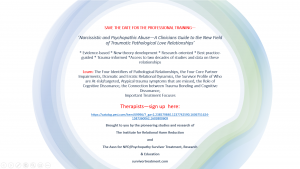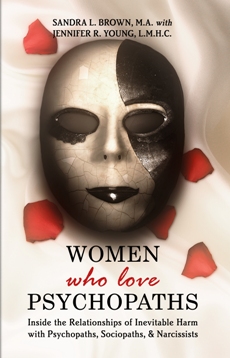by: Eleanor Payson, ACSW
Interview with Eleanor Payson, Licensed Clinical Social Worker and
author of ‘The Wizard of Oz and other Narcissists.’
(Editor’s note: The Institute has continued to write about and support the idea that many of the people in relationships with narcissists are not necessarily ‘co-dependents.’ That is because we stick strickly to the addiction-based assessment of co-dependency which is the partner or an addict. In this article Eleanor uses the word ‘co-dependent’ we believe, in a slightly different idea to incorporate other emotional and behavioral aspects.)
Interview by Harrison Koehli
1.) Why did you write your book?
In the eighties and nineties, I was dismayed by the lack of awareness and tools available for clients struggling in relationships with severely narcissistic individuals. My goal was to create a framework of understanding that would help clients heal and empower themselves in a variety of contexts; as the partner of a narcissist, the adult child of a narcissist, the coworker or client, or the friend of a narcissist.
On a more personal level, I am an adult child survivor (and today I would say “thriver”) of a narcissistic personality disordered (NPD) stepparent. My own healing work in therapy coincided with entering the field of social work as a chemical dependency treatment professional. In the eighties I worked with cocaine addicted individuals who were frequently identified as having severe narcissistic traits or full NPD, and I was fortunate to attend seminars and training programs with the experts at that time on narcissism. All of this eventually led to my passion to write an easy to understand book for codependents or individuals who find themselves in these painful and devastating relationships.
2.) What is the premise of it?
I believe the premise of my book is the same as my mission for writing it, which is to educate and help individuals extricate themselves from the corrosive dynamics that occur with narcissistic individuals. The solution to most problems begins with an elevation in consciousness first. So, I believe that when we begin to recognize and understand the dynamics that occur in these relationships, we can prevent and heal more quickly from the serious repercussions that erode our well being whether it is psychological, emotional, physical, financial, or perhaps even the loss of freedom. I also address the inevitable dynamics of codependency that develop or worsen when we become involved with a narcissistic individual. As we become fully conscious, emotionally and intellectually, we can steer a different course through the powerful force field of the narcissist’s personality.
Finally, I attempt to educate the lay public about the continuum of narcissism that can exist and help people to realize that it can take time for the full picture to emerge. As the codependent deals with her own issues and learns how to insist on more respectful and reciprocal exchange, the questions about the narcissistic individual’s capacity for change will eventually come to light. Sadly, all too often, as the codependent recovers her authentic self, the narcissistic issues in the other person are revealed to be the full narcissistic personality disorder (or a closely related personality disorder.) The good news is that the codependent can recover her authentic and whole self and choose a very different life.
3.) What kind of relationship dynamics do narcissists have in their relationships?
The word “dynamics” that you mention is the key to understanding these confounding relationships. In healthy relationships, there is a dynamic of mutuality – the shared consideration of giving and receiving. For example, it might be the consideration of noticing who arrived at a store counter first, or respectfully listening when someone is speaking and waiting one’s turn to share, or having empathy for who might be in need of a little extra support in a given context. The boundaries between self and other in healthy relationships simply unfold with an implicit understanding of a normal give-and-take. And typically the average person operates from a foundation of “giving the benefit of the doubt” when dealing with others, meaning a readiness to extend support and empathy to another person.
Unfortunately, as we encounter the narcissistic individual or the NPD person we discover that the implicit boundaries of mutuality are not operating, or perhaps I should say, they are only superficially operating. The personality presentation of the narcissist invariably has an intensity or potency that initially causes us to suspend our disbelief and turn off our critical faculties that allow us to notice distortions and inconsistencies. Intensity of presentation (either overt or covert) taps directly into the vulnerability of the codependent’s unconscious need to idealize others as a way of compensating for feelings of inadequacy and low self-worth. In short, the narcissist literally induces others into a trance and feeds on the stolen narcissistic supplies that inherently belong to both. Eventually, we encounter a host of painful dynamics from the narcissist’s unconscious mindset that places self as superior to other, self in competition with other and in a nutshell – self against other.
Although this mindset is a defense against a more deeply held sense of inadequacy, the narcissist’s entitlement feelings have a mighty strength of will behind them. This tenacious iron will is due to the identification with a grandiose self – some larger than life identity (even when covert as in the identity of a minister and, therefore, more difficult to observe.) All of this sets the stage for the narcissist’s desperate need to dominate the mental and emotional resources (narcissistic supplies) of attention, empathy, consideration, admiration and support in his/her relationships. The exploitation of the narcissistic supplies is one reason that the codependent becomes so depleted. In addition to depriving others of affirming and empathic behaviors, the narcissist also plays out the defense of projection – seeing his/her unwanted negative traits in others and communicates subtly or openly an endless array of devaluing messages. Finally, as the narcissist achieves greater degrees of dominance in a given relationship, he or she can “rewrite the program,” so to speak, over the identity of the other person. In the end, the narcissist exploits others for the additional privileges of status, money, power, and even the ability to take away the freedom of others.
4.) What kind of problems do your clients have in their relationships with narcissists?
To be on the receiving end of the dynamics just described is to slowly and continuously lose a sense of one’s core identity or core self. As we discussed earlier, narcissistic individuals often are drawn to individuals whose vulnerabilities are typically described as codependent. For those not familiar with the term, codependency is an overall tendency to compensate for low self-esteem by pleasing and gaining approval from others. Individuals with codependency issues are typically overly attuned to the feelings and needs of others at the cost of knowing and asserting their own. Problems with depression, anxiety, low self-esteem, and neuroses of all kinds are included in the array of issues that these clients might have. There is also a tendency to idealize others and invest trust too easily. Invariably the codependent individual suffers from abandonment fears, attachment hunger and a subsequent confusion and inability to recognize his or her inherent rights as a person. The good news from my perspective is that codependents more commonly fall into the neurotic level of mental disturbances, and consequently have much greater capacity for insight and motivation for change. Therefore, the picture is really very optimistic, and it is endlessly rewarding to work with codependents as they blossom and reclaim their lives.
5.) What if any treatment do you see possible for personality disorders – do you encourage couples counseling or for partners to wait it out while the narcissist is in treatment?
I hope you will bear with me as I attempt to answer the various aspects of your question.
Part of the problem with recommending treatment options for individuals presenting with narcissistic issues is that it is often not clear initially what level of narcissistic disturbance exists in the person. When the narcissistic person has already been assessed (by qualified and competent professionals) as having a personality disorder then the potential for change is extremely unlikely. However, the NPD individual can (and not infrequently does) make use of therapy in the supportive sense and sometimes also is willing to be treated for co-existing issues that are often part of the picture such as depression, anxiety disorders, mood disorders, and attention deficit disorder. The kind of change that an NPD person is capable of in this scenario is generally superficial, and therapy is used primarily to deal with some crisis that is stressful and threatening to his/her already fragile sense of self. I do wish, however, that mental health professionals were more willing to recognize that character disordered individuals can benefit from treatment for these co-existing issues, and we are in a unique position to advocate for this treatment. Despite the inability for deeper change, it can be an enormous relief, not only for the NPD individual but for family members also, when these co-existing conditions are to some degree alleviated.
Having said all this, the capacity for genuine change generally exists in those individuals who are in some type of relationship with the narcissist – provided, of course, that they are not personality disordered also. As I mentioned earlier, the changes that the codependent individual must work on involve developing a healthier sense of self alongside learning skills for effective limit setting and the implementation of firm, consistent and explicit boundaries that demand more appropriate behavior from the narcissist. Ultimately, there may be choices that involve ending the relationship with the narcissist or seriously limiting one’s exposure to him or her. These choices are generally necessary when the narcissist proves to be incapable of developing more appropriate behavior. Perhaps the most important imperative for family members, friends or their partners is to become educated about the problem so that so they do not stay stuck in the confounding and corrosive dynamics of these relationships.
I also encourage the codependent partner, family member, friend, etc. to enter into therapy and to attend codependency support group(s.) I feel proud to report that the women and men in Michigan who have been through our program over the years have started the first CONA group – Codependents of Narcissistic Individuals Anonymous (now officially sanctioned as a twelve step program by the World Service Headquarters of Alcoholics Anonymous.) For anyone reading this, I want to emphasize how necessary it is to reach out and get help and not stop until you feel you have found someone who can validate and understand what you are going through. If the therapist is overly anxious to dismiss the possibility that you are involved with someone with severe narcissism or perhaps a full blown NPD then move on until you find a therapist who does recognize the realities of the problem and who can offer support, validation, and empowerment strategies. I know that I am singing to the choir here, however, it is impossible to overstate the importance of getting help from experienced professionals familiar with these issues.
To return to the question of capacity for change on the part of the NPD person, I think sometimes when the NPD individual does show capacity for genuine change, then we have to acknowledge the possibility that the person may have been misdiagnosed in the first place. The real mystery cases are those individuals who seem to hover in the area between a “high functioning” personality disordered person versus a neurotic individual with strong narcissistic issues. Within this mystery group, the big question on the table has to do with the capacity for developing mature introspection and a sustained ability for change due to the development of empathy. Once family members or spouses develop insight and begin to change the asymmetry in the relationship with the NPD person, it becomes possible to tease out the deeper picture and to make choices that are founded on an accurate assessment of the level of functioning within the narcissistic person.
Consequently, I often recommend a combination of individual therapy (for both parties, but primarily for the codependent person because this person generally has a greater capacity for change) and marital or family therapy for the relational problems. I also recommend that separate therapists (working in co-ordination with each other) provide the different therapy requirements. When there are limited resources, I generally encourage the codependent person to attend individual therapy to heal and strengthen her sense of self so that the exploration for change with the narcissist or possibly ending her relationship with the narcissist is something she has the strength to do.
6.) How many years post treatment have you followed up to see how they are doing?
As a therapist in solo private practice, I do not have the resources to conduct follow-up surveys or research. I know that this is one of the great contributions that Sandra L. Brown, M.A. and others with The Institute are offering as they devote themselves to this important work, and I know it will continue to advance awareness and the development of effective treatment.
7.) What kind of parents do they make? What kind of stories do they tell you?
8.) What do the children say about their narcissistic parents? (Harrison, I hope you don’t mind that I combined these questions, as they are more or less the same.)
The stories of clients with NPD parents are incredibly varied and unique and yet, they are just as remarkably similar in the underlying and universally shared experience of reality. I will never forget a beautiful woman from a foreign country who had lived in America for only a few years. Having grown up with an NPD mother, she described her loss of self in the most poetic terms. She described her struggle to free herself as a process of erasing her mother’s initials that were carved into every cell in her mind. She went on to affirm how she was learning to penetrate the veil of her mother’s wants, thoughts and feelings as she discovered the choices that were her own.
Somehow, this woman’s description has stayed with me as a powerful expression of the loss of self that results when the child is held hostage to the NPD parent’s conditional expectations. Most important, however, is the reality that this potent mourning process brings the hope for healing and renewal. It is an amazing moment to awaken to a deeper knowing of self and to realize that we can reclaim our freedom from the unhappy tyranny of the conditional or false self. We need to realize that we can become victims of the conditional or false self in one of two ways – an inner or internalized false self, or conforming to the false self of someone else.
9.) What is the most troubling aspect of the personality disorder?
I would have to say that the most troubling aspect of these disorders are not just that they are life long problems for the personality disordered individuals, but too often it is a “life sentence of misery” for those who are involved with these individuals. This brings us full circle back to your first question that raised the question about the premise behind my book. I truly believe that we can change this reality. With enough education and effort to raise our collective consciousness about of the predatory nature of personality disorders, not only will there be fewer victims, but we may also discover more effective treatments for this population. In any case, I am passionate about helping to prevent and alleviate the “life sentence” for the would-be victims of individuals suffering from these personality afflictions.
10.) What relation, if any, have you found between depression, anxiety, etc. and interaction with people with personality disorders? Does the latter cause or exacerbate the former? (Harrison – This first question is a little fuzzy, but I think the second question clarifies it. I hope my answer addresses what you are asking.)
I’m not sure that anyone knows the answers to the important questions of causality with respect to personality disorders. We do know that there is a high incidence of co-morbid or co-existing conditions with respect to personality disorders and the array of other problems such as depression, mood disorders, anxiety, ADHD, addictions, anorexia, and the list goes on. I also think that we have to be very careful about causality interpretations, because this can very quickly take us on unnecessary detours that distort our understanding and treatment of the differences between these problems. The clinical term “co-morbid,” meaning co-existing, is an effective term because it reminds us that these are parallel, but not necessarily causative conditions. Having said this, it is absolutely true that these “parallel” conditions do amplify and exacerbate each other. As I mentioned earlier, when we successfully treat a co-morbid conditions (such as depression) it can be a significant achievement in lessening the overall destructive impact of the individual’s personality disorder.
11.) Have you found that a lucid explanation of personality disorders helps in the therapeutic process?
Yes, absolutely. After my book was released, the women and men who attended my public talks demonstrated a powerful need for greater clarification and understanding of the narcissistic personality disorder and the whole continuum of healthy to unhealthy degrees of narcissism. Eventually, these events grew almost organically into the development of our seminar program that came to be called Discovering the Healthy Self. I am convinced that education of these issues plays a potent role in accelerating a person’s capacity to heal and grow.
12.) Do you see a need for a more general understanding of personality disorders? And how do you see that happening?
Again an emphatic yes, and I know we are in great agreement about this. Since 2002 when my book was first published there were only a handful of books on this subject for the average reader. Since that time, a few dozen books have been published on the subject as well as important information about other personality disorders. Your wonderful web magazine and many blog sites also are getting the word out with important information about how to identify a potential personality disorder in a person and empowerment strategies for coping with these individuals.
13.) Can accurate knowledge about personality disorders act as a preventative measure against the negative influences of interactions with narcissists, for example?
Yes, I do think so. Perhaps the silver lining about the tragic consequences we are experiencing as a country is another reason that the subject is getting more attention. We now have a powerful need to understand how our government officials and experts in the banking world could have conducted themselves with such careless selfishness. The short answer is that so many of these individuals have personality disorders. My greatest hope for our society is that we become self aware enough as individuals that collectively we can detect what makes a healthy person healthy and conversely what clues tell us about a deeper disturbance. When we have developed a healthier consciousness about all this, I believe it will be less likely that we will elect such disturbed people to government office or allow them to gain prominent positions over our institutions.
As a conclusion, I would like to thank you Sandra for your wonderful work and dedication to furthering people’s awareness and understanding of these important issues. I also want to thank you for the opportunity to participate in this interview. My warmest regards to you and your staff.
Harrison, let me also thank you for your extremely patient and helpful support in the interview process.
———————————————————————————————————————————————————-
Eleanor Payson, ACSW, is a licensed marital and family therapist, practicing individual, marital, and family therapy for the past eighteen years. Graduating from the University of Michigan in 1983 with her Masters in Social Work, she has continued her education on issues ranging from; chemical dependency and codependency, adult children of alcoholics, narcissism and borderline personality disorders, relationship therapy, and attention deficit/hyperactivity disorder.
All content does not necessarily reflect the opinions of The Institute.






